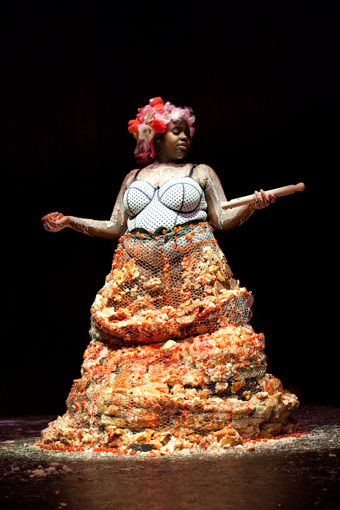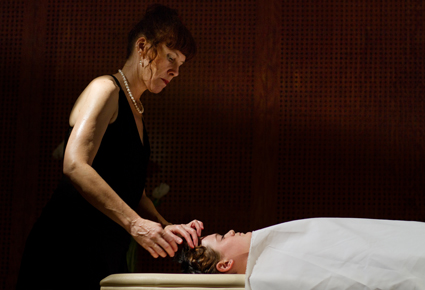Do you want me to touch you?
Madeleine Hodge, SPILL Festival of Performance

Selina Thompson, Pat it and prick it and mark it with b, SPILL Festival of Performance 2013
photo Pari Naderi
Selina Thompson, Pat it and prick it and mark it with b, SPILL Festival of Performance 2013
In the morning I am told Quizoola, Forced Entertainment’s iconic 24-hour question and answer performance, is sold out and despite their best efforts, the wonderful people at SPILL and at the Barbican have not been able to find a spare ticket.
I watch a little of it live online and in that 15 minutes a conversation takes place between Robin Arthur and Terry O’Connor in which he asks, “Would you like me to touch you?” She answers, “I wouldn’t mind if you touched me.” “But would you like me to touch you?” “I’m not saying I want you to touch me, but I wouldn’t mind if you touched me.” The audience laughs in the theatre far away.
Selina Thompson, Pat it and prick it…
SPILL National Platform takes place in a series of studios over three floors and the place is abuzz with activity. In Selina Thompson’s Pat it and prick it and mark it with b, in a room on the ground floor the artist is making a dress out of cake. Soul music plays on an iPod and the smell of cake fills the air. People are invited to help, cakes come out of the oven, are layered on to a cake rack and stuck together with jam and pink icing. It’s a performance that makes itself. Delightfully unselfconscious, the artist and her best friend and helper walk about, baking and working in their underwear, singing a bit and talking casually with the audience who seem to become Thompson’s friends in the process. On the walk upstairs, from one performance to the next, “on contact” is scrawled on the walls, evoking the theme of the festival with marker pens and paper.
Julie Vulcan, I Stand In

Julie Vulcan, I Stand In, SPILL Festival of Performance 2013
photo Pari Naderi
Julie Vulcan, I Stand In, SPILL Festival of Performance 2013
Entering Australian artist Julie Vulcan’s I Stand In, the first hit to my senses is a warm, gentle balm for the brain—the smell of healing oils. Vulcan stands at the other end of the room in front of a wood panelled wall with an altar of white flowers to one side and a body, beneath a white cloth, laid out before her on a table. The backdrop suggests a Hawaiian funeral parlour. The ritual begins with the removal of the cloth. The body is firmly massaged for 15 minutes. The artist cradles the heavy, limp body in order to oil the back. It is possible to imagine it is not breathing.
The most striking thing about witnessing this eight-hour performance is that each touch on the participant’s body creates a haptic connection with my own, each part responds as though the touch is happening directly on my own arm, my cheek. I realise that my body, more than my mind, is witness, responding before I think. In its generosity to the bodies of both the participants and the audience, I Stand In reminds us of the care we can enact towards each another. It reminds us of the strangers’ hands that guide us from our mothers’ wombs, that nurse us when we are sick and the hands that care for us in death. It reminds us that we are all part of the cycle of care, that our bodies recognise before the mind has time to catch up.
Heather Cassils, Becoming an image
On entering Heather Cassils’ Becoming an image on the lower floor of the building we are held in a black ingress so, we are told, our eyes can adjust to complete darkness. In low light the audience sits on the floor around a grey mound.
Sounds come first, a hiss, phut, huh; those of a fighter warming up. They get louder, stronger and then violent as fists hit something solid. Like a shock delivered straight into the brain, the image is there of a body, small and strong, flung against the mound of clay.
Photographer Manual Vason is Cassils’ performance partner in the work in which the only light is the flash of his camera. We see Cassils punching the clay, working to break down the mound. The fight is intimate, sexual, the smell of sweat adding another sensory layer. The performance takes place mostly in the afterburn on the retina, as in the darkness we try to catch up with the shock contact of light on the surface of our eyes, the image of the artist’s body leaving traces of negative images. In the gaps in our vision it is possible to make out the shape of something bigger that is alluded to in this performance, a summary of what we miss in the darkness, the invisible fights against the monumentalism of history. In the words of Heather Cassils, “You have to break things down to build things up.”
SPILL Festival of Performance 2013, producer Pacitti Company, London, 3-14 April; spillfestival.com/
RealTime issue #115 June-July 2013 pg. 12






